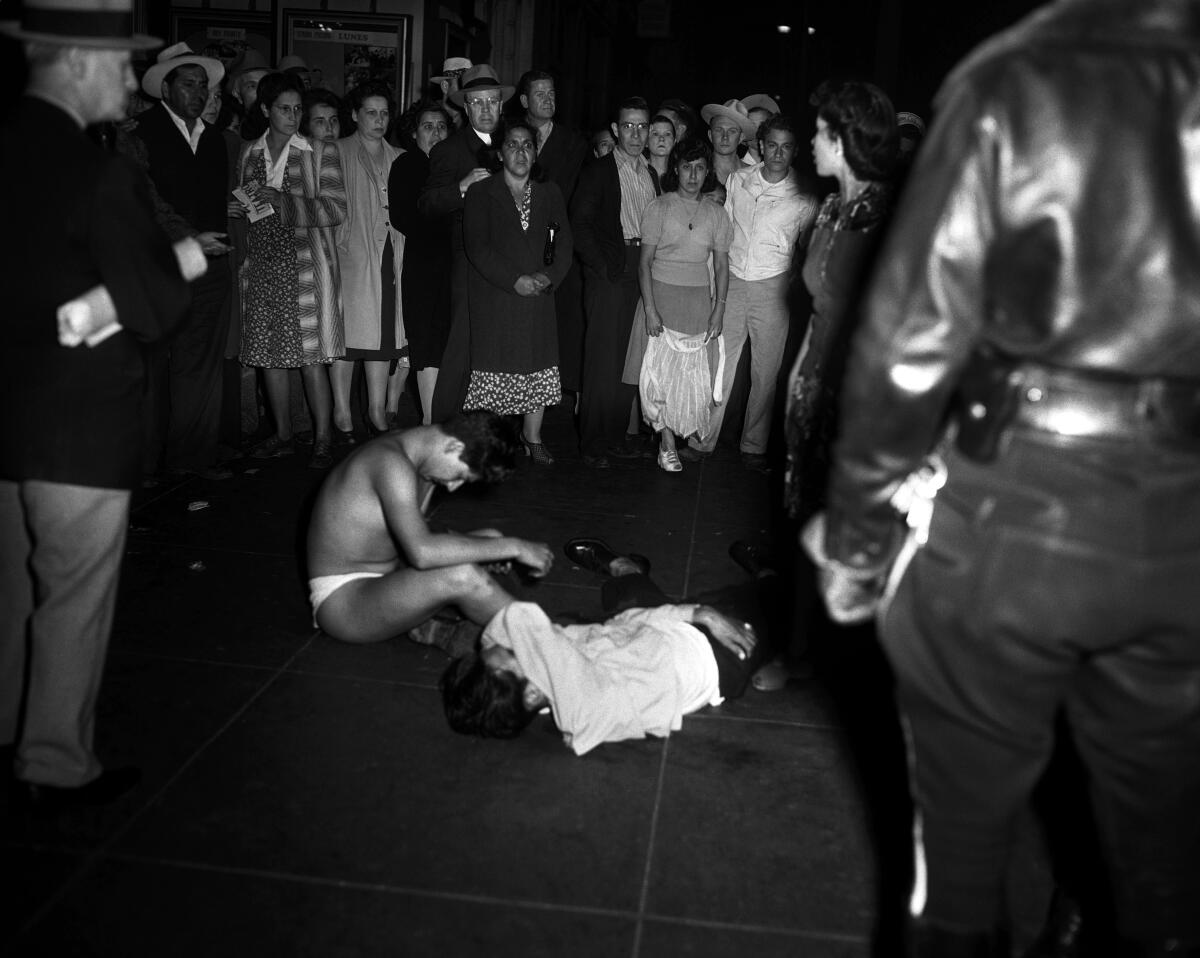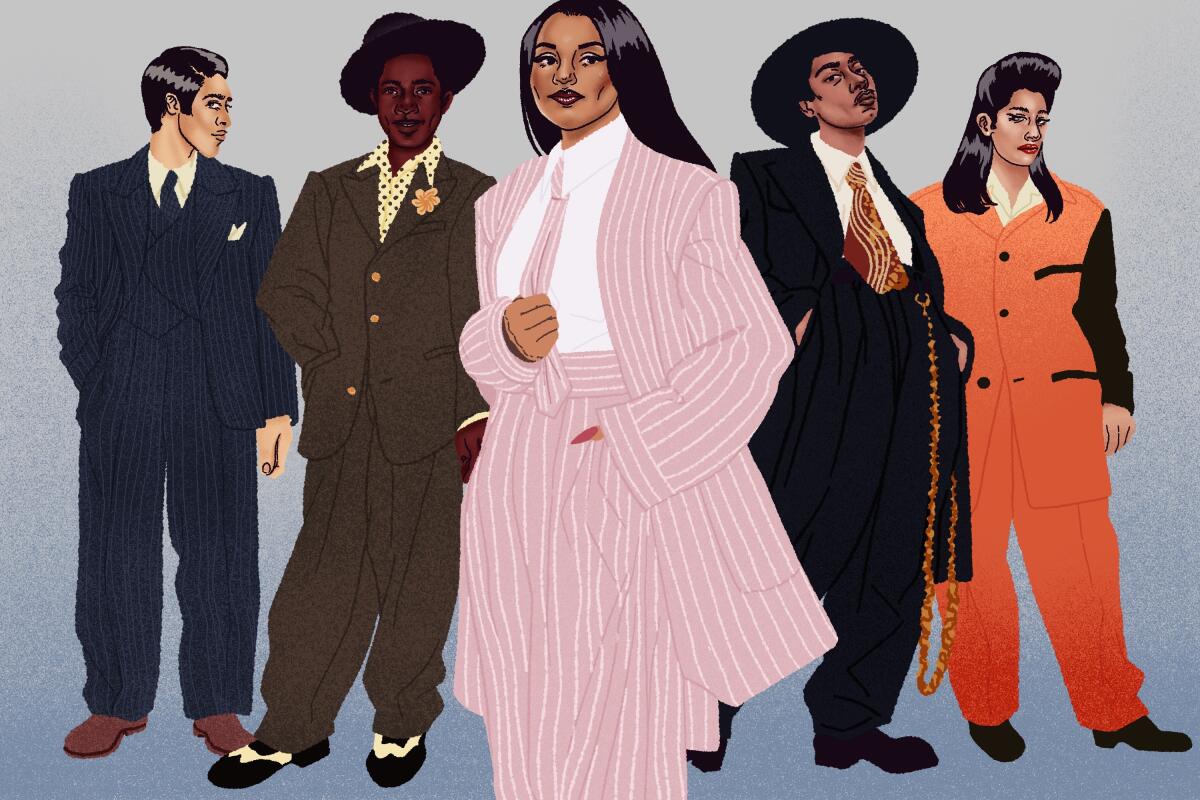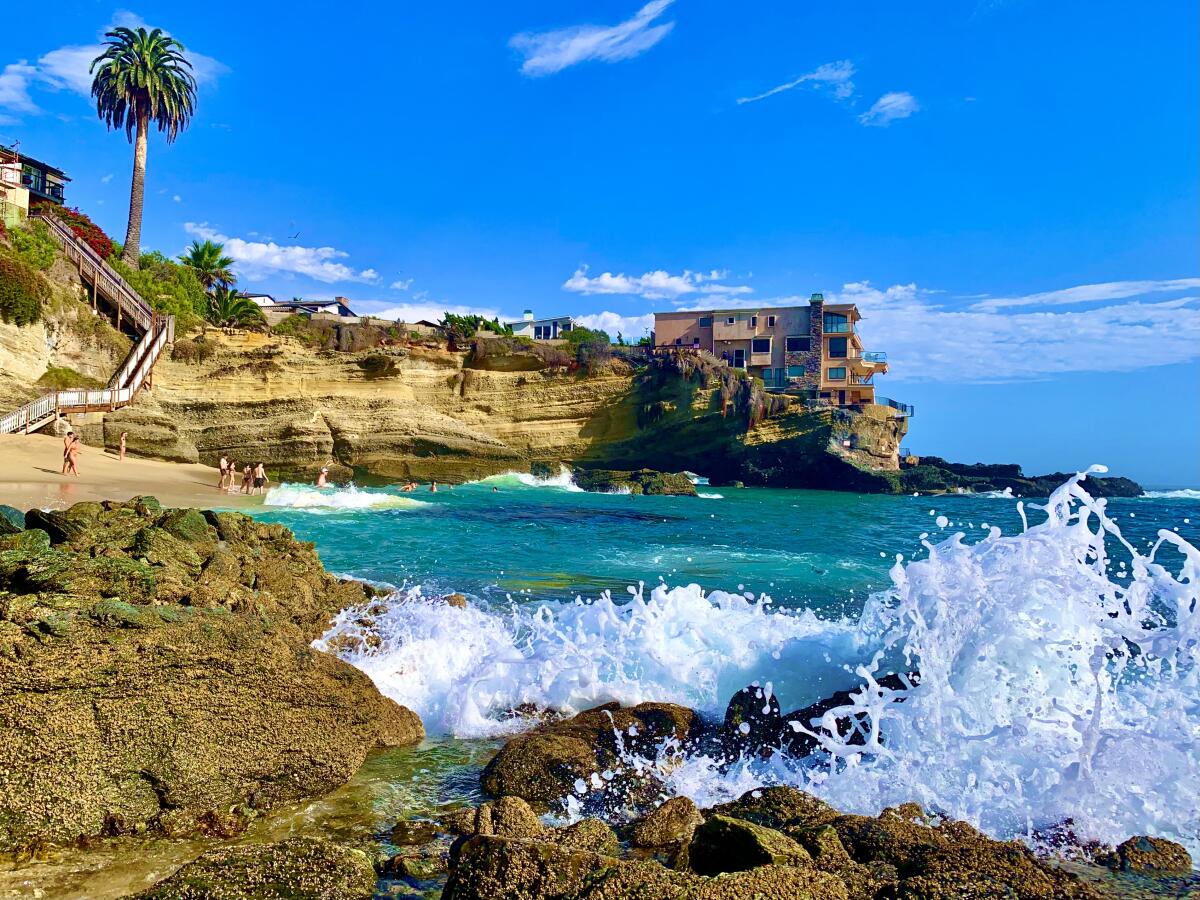The Zoot Suit Riots, 80 years later

- Share via
Good morning, and welcome to the Essential California newsletter. It’s Monday, June 26. I’m Steve Padilla, editor of Column One, The Times’ showcase for storytelling. This month marks the 80th anniversary of one of the most shameful events in L.A. history — the Zoot Suit Riots — and that’s gotten me thinking about something my father once told me.
Dad grew up in Boyle Heights, and like lots of Mexican American boys and young men in the 1940s, he really wanted a zoot suit — those flashy outfits with tapered, high-waisted pants, fingertip coats and dashing hats, preferably graced with a feather. No way, said his mom. Good thing too. During the chaos of what became known as the Zoot Suit Riots, Dad saw sailors descend on a young zoot suiter, beat him and strip him of his clothes. Such scenes played out again and again throughout Southern California in June of 1943.

The riots were an extreme expression of a wartime fear of what was perceived as foreign and different, my colleague Christian Orozco explained in a detailed timeline enhanced with archival photos.
The zoot suit had crossed racial and ethnic lines — Black and Filipino young men wore them too, along with some white Angelenos — but rampaging crowds of sailors, other servicemen and white Angelenos targeted Mexican Americans in their determination to clear the streets of the guys in “freak suits.”
Sadly, “freak suits” is just one of many unfortunate word choices the L.A. Times made about the suits and those who wore them. “Gamin’ dandies,” they were called. “Hoodlums” was another favorite term. We weren’t the only newspaper to demonize pachucos or promote violence; radio stations piled on too, even broadcasting where the night’s mayhem was expected to happen. As a fellow Times editor, Shelby Grad, pointed out, the riots amounted to state-sanctioned chaos, and by “state” he meant the media, military, business community and local governments. Such complicity underscores the significance of recent resolutions by the Los Angeles County Board of Supervisors and Los Angeles City Council, which denounced the violence and apologized for their role in the unrest.
The legacy of the riots has never really left the consciousness of the Mexican American community, but the riots remain largely unknown to the public.
I mentioned my dad and his unfulfilled desire for a zoot suit. Reporter Louis Sahagún told me that his father wanted one too and was more successful. Sort of. Louis’ dad saved up and bought a set of “drapes,” as they were called. When his father discovered the zoot suit, he promptly took out a pair of scissors and cut it up.
More about the riots
Zoot suit: How the bold look made history and continues to influence fashion. Carolina A. Miranda took a deep dive into zoot suit culture and fashion, tracing the suit’s origins to Harlem, where it was popular among African Americans. Carolina also shared an unexpected fact: how the suit’s basic contours could be linked to designs favored by a future king of England.
The untold story of how Black L.A. defended Mexican Americans during the Zoot Suit Riots. The riots are often portrayed as a conflict between white and brown L.A. My colleague Gustavo Arellano’s surprising and inspiring story of how leaders of L.A.’s Black community defended the zoot suiters is all the more relevant, he wrote, given the racist remarks Latino leaders made about the Black community in last year’s infamous recording.
- Gustavo talked about the riots on KQED. I’m on the show too, but you’ll really want to hear from Gustavo and Elizabeth Escobedo, an associate professor of history at the University of Denver and author of “From Coveralls to Zoot Suits: The Lives of Mexican American Women on the World War II Home Front.”
By exploring L.A.’s racial injustice, Luis Valdez’s ‘Zoot Suit’ gave birth to Chicano theater. I may have learned about zoot suits and the riots from Dad, but many Angelenos, including members of the Mexican American community, were introduced to those dark days by Luis Valdez’s groundbreaking play “Zoot Suit.” Times reporter Reed Johnson chatted with Valdez on the play’s origins, legacy and lasting impact on Chicano theater. He also interviewed the original El Pachuco himself: Edward James Olmos. I confess to being jealous about this because Reed got to hear Olmos recite his original opening monologue. (Reed, you couldn’t conference call?)
More:
- Be sure to check out the video of the 1940s zoot suit acquired by the Los Angeles County Museum of Art. It’s one of two terrific videos by Steve Saldivar.
And now, here’s what’s happening across California, compiled by Essential California editor Laura Blasey:
Note: Some of the sites we link to may limit the number of stories you can access without subscribing.
L.A. STORIES
Coliseum turns 100: Timeless Los Angeles cultural centerpiece endures as an icon. Over the past century, the Coliseum has been a cultural centerpiece for sprawling L.A., a place for sports, rock concerts, papal visits and even ski jumping. Los Angeles Times
20 years ago, the Arroyo Seco Parkway turned into a car-free party. Get ready for another. In October, six miles of the 110 Freeway connecting Los Angeles and Pasadena — the West Coast’s oldest freeway — is set to close down for people to walk, bike, skate and run. Los Angeles Times
POLITICS AND GOVERNMENT
Walgreens pharmacist cites his religion for denying a transgender man’s hormone replacement meds. For nearly three years, a 30-year transgender man says he picked up his hormone-replacement therapy prescriptions at the same Walgreens in Oakland without a hitch. That changed on Monday, when he said a pharmacist denied his medication. Los Angeles Times
CRIME, COURTS AND POLICING
Fights, beatings and a birth: Videos smuggled out of L.A. jails reveal violence, neglect. The Times reviewed a few dozen graphic videos from the past six years saved to a thumb drive picked out of the trash by one inmate, and later secreted out of the jail by another. Together they paint a picture of a jail system awash in far more violence and disarray than previously revealed to the public. Los Angeles Times
Human remains found in Mt. Baldy wilderness amid search for missing actor Julian Sands. Hikers around Mt. Baldy discovered a body around 10 a.m. and notified authorities, according to a statement from the San Bernardino County Sheriff’s Department. Sands has been missing since Jan. 13. Los Angeles Times
Support our journalism
HEALTH AND THE ENVIRONMENT
Can a $20-million liability fund encourage more ‘good fire’ in California? Many experts insist that the state must expand the use of controlled burns to clear forests of excess fuel and restore ecosystem health. A key barrier has been the inability to obtain insurance coverage for burn operations, but a new state program seeks to solve that problem. Los Angeles Times
SoCal submarine tour business motors on in shadow of Titan disaster. A submersible called the Titan suffered a “catastrophic implosion” during its descent to inspect the wreck of the Titanic on June 18, killing the five people aboard. The wall-to-wall news coverage threatened to cast a pall over the underwater tourism business in Southern California, although members of the industry hastened to point out the many differences between the kinds of excursions on offer here and the one that ended in tragedy. Los Angeles Times
CALIFORNIA CULTURE
SAG-AFTRA leaders cite ‘extremely productive’ contract talks with Hollywood studios. In a video message to members Saturday, SAG-AFTRA President Fran Drescher and Chief Negotiator Duncan Crabtree-Ireland shared no details of the talks but said they were progressing well, suggesting Hollywood may avert a second strike. Los Angeles Times
- Hollywood directors approve new contract with studios.
The sun is out and grilling season is here. This is how we do it in L.A. Grilling is a feature of almost every culinary culture, and it’s all reflected in L.A.’s interlocking communities. Filipino skewers. Japanese yakitori. Middle Eastern kebab. Argentine and Chilean asados. Thai satays. And of course, Korean barbecue. Los Angeles Times
Free online games
Get our free daily crossword puzzle, sudoku, word search and arcade games in our new game center at latimes.com/games.
AND FINALLY
Today’s California landmark is from Elyse Jankowski: Table Rock Beach in Laguna Beach, Calif.

Elyse writes:
Table Rock Beach in Laguna Beach is a paradise off PCH. Its seclusion and steep staircase add a sense of secrecy, though locals certainly frequent this favored sandy spot.
What are California’s essential landmarks? Fill out this form to send us your photos of a special spot in California — natural or human-made. Tell us why it’s interesting and what makes it a symbol of life in the Golden State. Please be sure to include only photos taken directly by you. Your submission could be featured in a future edition of the newsletter.
Please let us know what we can do to make this newsletter more useful to you. Send comments to [email protected].
Sign up for Essential California
The most important California stories and recommendations in your inbox every morning.
You may occasionally receive promotional content from the Los Angeles Times.




